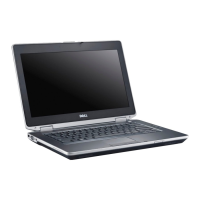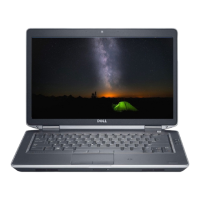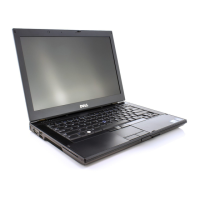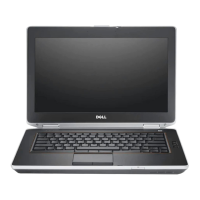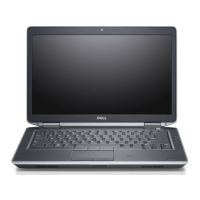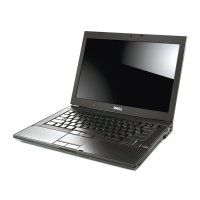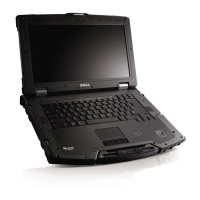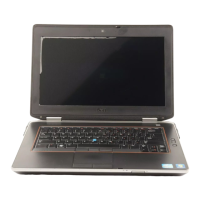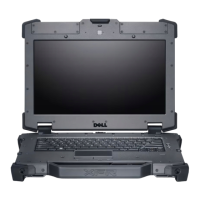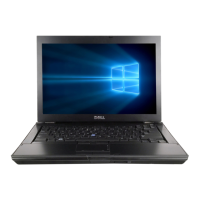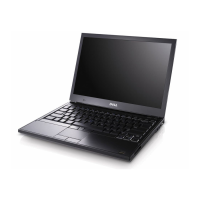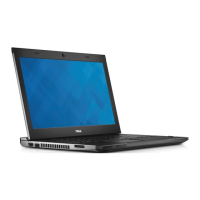Do you have a question about the Dell Latitude E6430s and is the answer not in the manual?
Provides safety guidelines and steps to prepare the computer before performing internal procedures.
Details the procedure for safely shutting down the operating system and the computer.
Outlines the steps to reconnect devices and cables after internal component work.
Lists essential tools required for component removal and installation procedures.
Step-by-step instructions for safely removing the SD card from the computer.
Step-by-step instructions for safely installing the SD card into the computer.
Instructions for safely removing the ExpressCard from its slot.
Instructions for safely installing the ExpressCard into its slot.
Detailed steps to remove the main battery from the laptop.
Detailed steps to install the main battery into the laptop.
Procedure to remove the SIM card from its compartment.
Procedure to install the SIM card into its compartment.
Step-by-step guide to safely remove the hard drive from the computer.
Step-by-step guide to safely install the hard drive into the computer.
Instructions for safely removing the optical drive from the computer.
Instructions for safely installing the optical drive into the computer.
Procedure to remove the computer's base cover.
Procedure to install the computer's base cover.
Instructions for removing the keyboard trim from the computer.
Instructions for installing the keyboard trim onto the computer.
Step-by-step guide to remove the keyboard from the computer.
Step-by-step guide to install the keyboard onto the computer.
Procedure to remove the WLAN card from the computer.
Procedure to install the WLAN card into the computer.
Procedure to remove the Bluetooth module from the computer.
Procedure to install the Bluetooth module into the computer.
Instructions for removing the memory modules from the computer.
Instructions for installing the memory modules into the computer.
Procedure to remove the coin-cell battery from the system board.
Procedure to install the coin-cell battery onto the system board.
Steps to remove the palmrest assembly from the computer.
Steps to install the palmrest assembly onto the computer.
Procedure to remove the media board from the computer.
Procedure to install the media board into the computer.
Procedure to remove the ExpressCard cage from the computer.
Procedure to install the ExpressCard cage into the computer.
Procedure to remove the speakers from the computer.
Procedure to install the speakers into the computer.
Procedure to remove the display-hinge covers from the computer.
Procedure to install the display-hinge covers onto the computer.
Procedure to remove the display assembly from the computer.
Procedure to install the display assembly onto the computer.
Procedure to remove the system board from the computer.
Procedure to install the system board into the computer.
Procedure to remove the heat sink from the system board.
Procedure to install the heat sink onto the system board.
Procedure to remove the power connector port from the computer.
Procedure to install the power connector port onto the computer.
Procedure to remove the Input/Output (I/O) board from the computer.
Procedure to install the Input/Output (I/O) board into the computer.
Procedure to remove the display bezel from the display assembly.
Procedure to install the display bezel onto the display assembly.
Procedure to remove the display panel from the display assembly.
Procedure to install the display panel onto the display assembly.
Procedure to remove the camera and microphone module.
Procedure to install the camera and microphone module.
Procedure to remove the LED board from the display assembly.
Procedure to install the LED board onto the display assembly.
Procedure to remove the display-hinge walls from the display assembly.
Procedure to install the display-hinge walls onto the display assembly.
Procedure to remove the display hinges from the computer.
Procedure to install the display hinges onto the computer.
Procedure to remove the LVDS and camera cable from the display assembly.
Procedure to install the LVDS and camera cable onto the display assembly.
Bypasses setup-defined order to boot directly to a specific device.
Details the keys used for navigating and interacting within the system setup.
Lists the primary hardware features of the computer.
Displays the charge status of the computer's battery.
Allows setting the computer's date and time.
Allows configuration of the integrated network controller.
Defines and sets the parallel port operation, typically for docking stations.
Identifies and defines the serial port settings for the computer.
Allows configuration of the internal SATA hard-drive controller.
Allows configuration of the SATA drives on board the computer.
Controls reporting of hard drive errors during system startup.
Allows definition of USB configuration, including boot support and external ports.
Configures the behavior of the USB PowerShare feature.
Allows choosing the operating mode of the keyboard illumination feature.
Sets the mode to turn off light and sound emissions from the system.
Enables or disables various on-board devices.
Sets panel brightness, especially when the ambient sensor is off.
Allows enabling or disabling the NVIDIA Optimus technology.
Configuration for Intel Trusted Execution Technology.
Allows setting, changing, or deleting the administrator password.
Allows setting, changing, or deleting the system password for logon.
Allows setting, changing, or deleting the password for the internal HDD.
Enforces the option to always set strong passwords.
Defines the length of the password.
Allows enabling or disabling bypassing of system and HDD passwords.
Permits or restricts setup option changes by non-administrators.
Enables the Trusted Platform Module (TPM) during POST.
Enables the Execute Disable mode of the processor.
Activates or deactivates the optional Computrace software.
Sets access to Option ROM Configuration screens using hotkeys.
Prevents users from entering Setup when an administrator password is set.
Specifies whether multiple processor cores are enabled for performance.
Enables or disables the Intel SpeedStep feature.
Enables or disables additional processor sleep states.
Enables or disables the Intel TurboBoost mode of the processor.
Enables or disables the HyperThreading feature in the processor.
Controls automatic power-on when the AC adapter is plugged in.
Sets the time for automatic computer power-on.
Enables USB devices to wake the computer from standby mode.
Controls the WLAN and WWAN radio devices.
Allows the computer to power up from off state via LAN signal.
Blocks the computer from entering the sleep state.
Defines how the battery charge is used when AC is plugged in.
Defines how to charge the battery.
Activates warning messages for specific power adapters.
Defines how the computer handles mouse and touchpad input.
Specifies if the NumLock function is enabled when the computer boots.
Matches the <Scroll Lock> key feature with the <Fn> key.
Specifies whether keyboard related errors are reported during boot.
Displays keystroke sequence to enter the BIOS Boot Option Menu.
Allows speeding up the boot processes.
Specifies VMM utilization of additional hardware capabilities via Intel Virtualization.
Enables or disables VMM utilization of hardware capabilities for direct I/O.
Determines control of wireless devices via the wireless switch.
Enables or disables wireless devices like WWAN, Bluetooth, and WLAN.
Displays the service tag of your computer.
Allows creation of a system asset tag if not already set.
Displays the system event log and allows clearing the log.
Recommended steps for updating the BIOS, especially after hardware changes.
Explains system and setup passwords for securing the computer.
Guides on setting or changing system and setup passwords.
Procedure to delete or change existing system and setup passwords.
Comprehensive hardware check embedded with BIOS, launched internally.
Explains the meaning of device status LEDs for connectivity and activity.
Interprets battery status lights for power and charging conditions.
Provides safety guidelines and steps to prepare the computer before performing internal procedures.
Details the procedure for safely shutting down the operating system and the computer.
Outlines the steps to reconnect devices and cables after internal component work.
Lists essential tools required for component removal and installation procedures.
Step-by-step instructions for safely removing the SD card from the computer.
Step-by-step instructions for safely installing the SD card into the computer.
Instructions for safely removing the ExpressCard from its slot.
Instructions for safely installing the ExpressCard into its slot.
Detailed steps to remove the main battery from the laptop.
Detailed steps to install the main battery into the laptop.
Procedure to remove the SIM card from its compartment.
Procedure to install the SIM card into its compartment.
Step-by-step guide to safely remove the hard drive from the computer.
Step-by-step guide to safely install the hard drive into the computer.
Instructions for safely removing the optical drive from the computer.
Instructions for safely installing the optical drive into the computer.
Procedure to remove the computer's base cover.
Procedure to install the computer's base cover.
Instructions for removing the keyboard trim from the computer.
Instructions for installing the keyboard trim onto the computer.
Step-by-step guide to remove the keyboard from the computer.
Step-by-step guide to install the keyboard onto the computer.
Procedure to remove the WLAN card from the computer.
Procedure to install the WLAN card into the computer.
Procedure to remove the Bluetooth module from the computer.
Procedure to install the Bluetooth module into the computer.
Instructions for removing the memory modules from the computer.
Instructions for installing the memory modules into the computer.
Procedure to remove the coin-cell battery from the system board.
Procedure to install the coin-cell battery onto the system board.
Steps to remove the palmrest assembly from the computer.
Steps to install the palmrest assembly onto the computer.
Procedure to remove the media board from the computer.
Procedure to install the media board into the computer.
Procedure to remove the ExpressCard cage from the computer.
Procedure to install the ExpressCard cage into the computer.
Procedure to remove the speakers from the computer.
Procedure to install the speakers into the computer.
Procedure to remove the display-hinge covers from the computer.
Procedure to install the display-hinge covers onto the computer.
Procedure to remove the display assembly from the computer.
Procedure to install the display assembly onto the computer.
Procedure to remove the system board from the computer.
Procedure to install the system board into the computer.
Procedure to remove the heat sink from the system board.
Procedure to install the heat sink onto the system board.
Procedure to remove the power connector port from the computer.
Procedure to install the power connector port onto the computer.
Procedure to remove the Input/Output (I/O) board from the computer.
Procedure to install the Input/Output (I/O) board into the computer.
Procedure to remove the display bezel from the display assembly.
Procedure to install the display bezel onto the display assembly.
Procedure to remove the display panel from the display assembly.
Procedure to install the display panel onto the display assembly.
Procedure to remove the camera and microphone module.
Procedure to install the camera and microphone module.
Procedure to remove the LED board from the display assembly.
Procedure to install the LED board onto the display assembly.
Procedure to remove the display-hinge walls from the display assembly.
Procedure to install the display-hinge walls onto the display assembly.
Procedure to remove the display hinges from the computer.
Procedure to install the display hinges onto the computer.
Procedure to remove the LVDS and camera cable from the display assembly.
Procedure to install the LVDS and camera cable onto the display assembly.
Bypasses setup-defined order to boot directly to a specific device.
Details the keys used for navigating and interacting within the system setup.
Lists the primary hardware features of the computer.
Displays the charge status of the computer's battery.
Allows setting the computer's date and time.
Allows configuration of the integrated network controller.
Defines and sets the parallel port operation, typically for docking stations.
Identifies and defines the serial port settings for the computer.
Allows configuration of the internal SATA hard-drive controller.
Allows configuration of the SATA drives on board the computer.
Controls reporting of hard drive errors during system startup.
Allows definition of USB configuration, including boot support and external ports.
Configures the behavior of the USB PowerShare feature.
Allows choosing the operating mode of the keyboard illumination feature.
Sets the mode to turn off light and sound emissions from the system.
Enables or disables various on-board devices.
Sets panel brightness, especially when the ambient sensor is off.
Allows enabling or disabling the NVIDIA Optimus technology.
Configuration for Intel Trusted Execution Technology.
Allows setting, changing, or deleting the administrator password.
Allows setting, changing, or deleting the system password for logon.
Allows setting, changing, or deleting the password for the internal HDD.
Enforces the option to always set strong passwords.
Defines the length of the password.
Allows enabling or disabling bypassing of system and HDD passwords.
Permits or restricts setup option changes by non-administrators.
Enables the Trusted Platform Module (TPM) during POST.
Enables the Execute Disable mode of the processor.
Activates or deactivates the optional Computrace software.
Sets access to Option ROM Configuration screens using hotkeys.
Prevents users from entering Setup when an administrator password is set.
Specifies whether multiple processor cores are enabled for performance.
Enables or disables the Intel SpeedStep feature.
Enables or disables additional processor sleep states.
Enables or disables the Intel TurboBoost mode of the processor.
Enables or disables the HyperThreading feature in the processor.
Controls automatic power-on when the AC adapter is plugged in.
Sets the time for automatic computer power-on.
Enables USB devices to wake the computer from standby mode.
Controls the WLAN and WWAN radio devices.
Allows the computer to power up from off state via LAN signal.
Blocks the computer from entering the sleep state.
Defines how the battery charge is used when AC is plugged in.
Defines how to charge the battery.
Activates warning messages for specific power adapters.
Defines how the computer handles mouse and touchpad input.
Specifies if the NumLock function is enabled when the computer boots.
Matches the <Scroll Lock> key feature with the <Fn> key.
Specifies whether keyboard related errors are reported during boot.
Displays keystroke sequence to enter the BIOS Boot Option Menu.
Allows speeding up the boot processes.
Specifies VMM utilization of additional hardware capabilities via Intel Virtualization.
Enables or disables VMM utilization of hardware capabilities for direct I/O.
Determines control of wireless devices via the wireless switch.
Enables or disables wireless devices like WWAN, Bluetooth, and WLAN.
Displays the service tag of your computer.
Allows creation of a system asset tag if not already set.
Displays the system event log and allows clearing the log.
Recommended steps for updating the BIOS, especially after hardware changes.
Explains system and setup passwords for securing the computer.
Guides on setting or changing system and setup passwords.
Procedure to delete or change existing system and setup passwords.
Comprehensive hardware check embedded with BIOS, launched internally.
Explains the meaning of device status LEDs for connectivity and activity.
Interprets battery status lights for power and charging conditions.
| Form factor | Clamshell |
|---|---|
| Product type | Laptop |
| Product color | Black, Silver |
| Bus type | DMI |
| Stepping | L1 |
| Tjunction | 105 °C |
| Processor cache | 3 MB |
| Processor cores | 2 |
| Processor model | i5-3340M |
| System bus rate | 5 GT/s |
| Processor family | Intel® Core™ i5 |
| Processor series | Intel Core i5-3300 Mobile series |
| Processor socket | BGA 1023 |
| Processor threads | 4 |
| Processor codename | Ivy Bridge |
| Processor frequency | 2.7 GHz |
| Processor cache type | Smart Cache |
| Processor lithography | 22 nm |
| Processor manufacturer | Intel |
| Processor front side bus | - MHz |
| PCI Express slots version | 3.0 |
| Processor boost frequency | 3.4 GHz |
| Processor operating modes | 64-bit |
| ECC supported by processor | No |
| PCI Express configurations | 1x16, 2x8, 1x8+2x4 |
| Thermal Design Power (TDP) | 35 W |
| CPU multiplier (bus/core ratio) | 27 |
| Maximum number of PCI Express lanes | 16 |
| Motherboard chipset | Intel® QM77 Express |
| Internal memory | 2 GB |
| Memory clock speed | 1600 MHz |
| Internal memory type | DDR3-SDRAM |
| Maximum internal memory | 8 GB |
| Memory layout (slots x size) | 1 x 2 GB |
| HDD speed | 5400 RPM |
| Storage media | HDD |
| Optical drive type | DVD±RW |
| Card reader integrated | - |
| Total storage capacity | 320 GB |
| Number of HDDs installed | 1 |
| LED backlight | Yes |
| Display diagonal | 14 \ |
| Display resolution | 1366 x 768 pixels |
| Native aspect ratio | 16:9 |
| On-board graphics card ID | 0x166 |
| Discrete graphics card model | Not available |
| On-board graphics card model | Intel® HD Graphics 4000 |
| On-board graphics card family | Intel® HD Graphics |
| On-board graphics card base frequency | 650 MHz |
| On-board graphics card dynamic frequency (max) | 1250 MHz |
| Wi-Fi standards | 802.11g, Wi-Fi 4 (802.11n) |
| Bluetooth version | 4.0 |
| Ethernet LAN data rates | 10, 100, 1000 Mbit/s |
| Charging port type | DC-in jack |
| USB 2.0 ports quantity | 0 |
| Pointing device | Touchpad |
| Trial software | McAfee Security Center, Microsoft Office |
| Operating system installed | Windows 7 Professional |
| Processor code | SR0XB |
| Processor ARK ID | 71257 |
| Processor package size | 37.5 x 37.5 (rPGA988B); 31.0 x 24.0 (BGA1023) mm |
| Supported instruction sets | AVX |
| Intel Identity Protection Technology version | 1.00 |
| Battery life (max) | - h |
| Number of battery cells | 6 |
| AC adapter power | 90 W |
| Sustainability certificates | ENERGY STAR |
| Depth | 233.3 mm |
|---|---|
| Width | 335 mm |
| Weight | 1700 g |
| Height (rear) | 30.9 mm |
| Height (front) | 26.8 mm |
